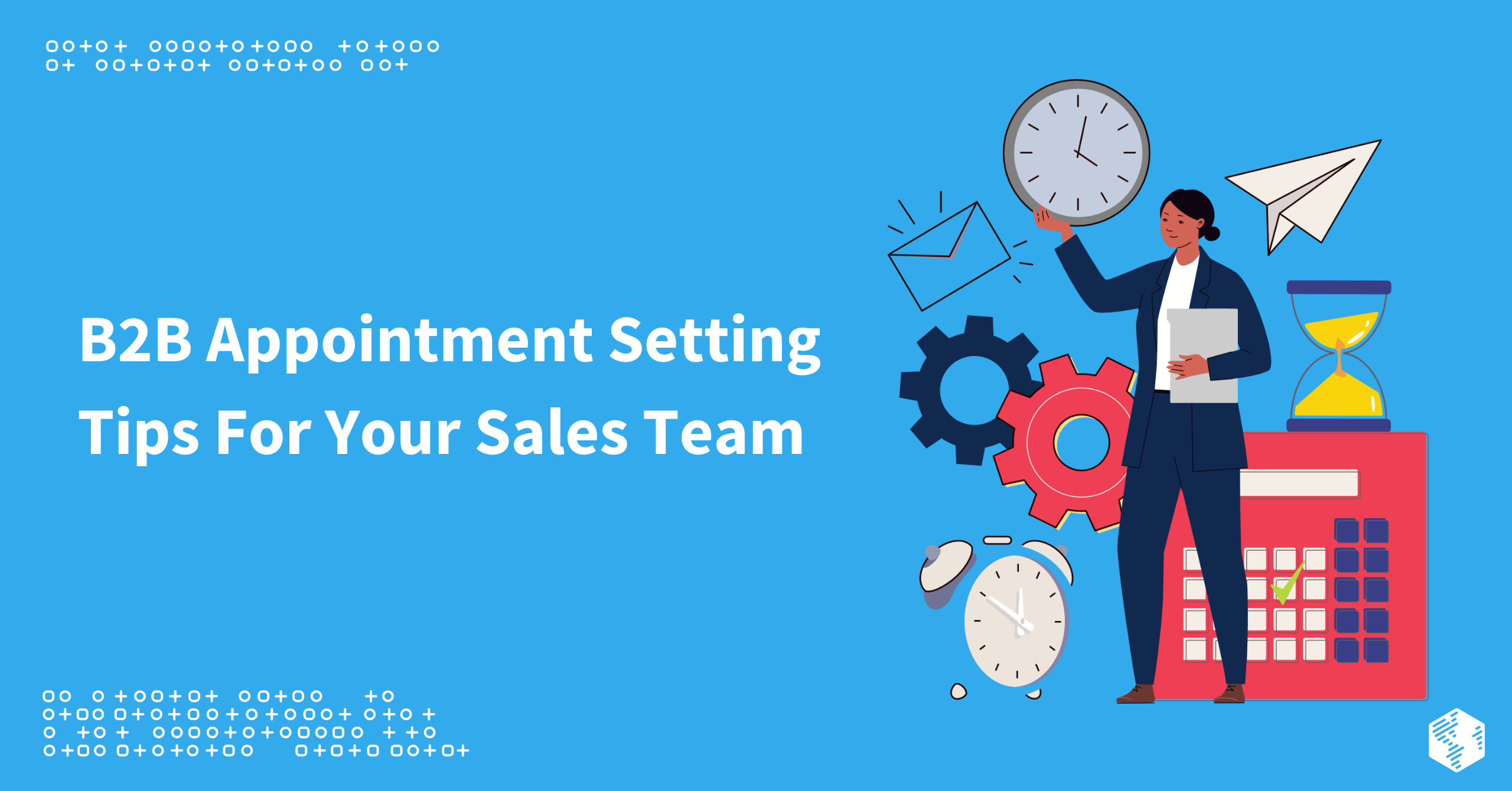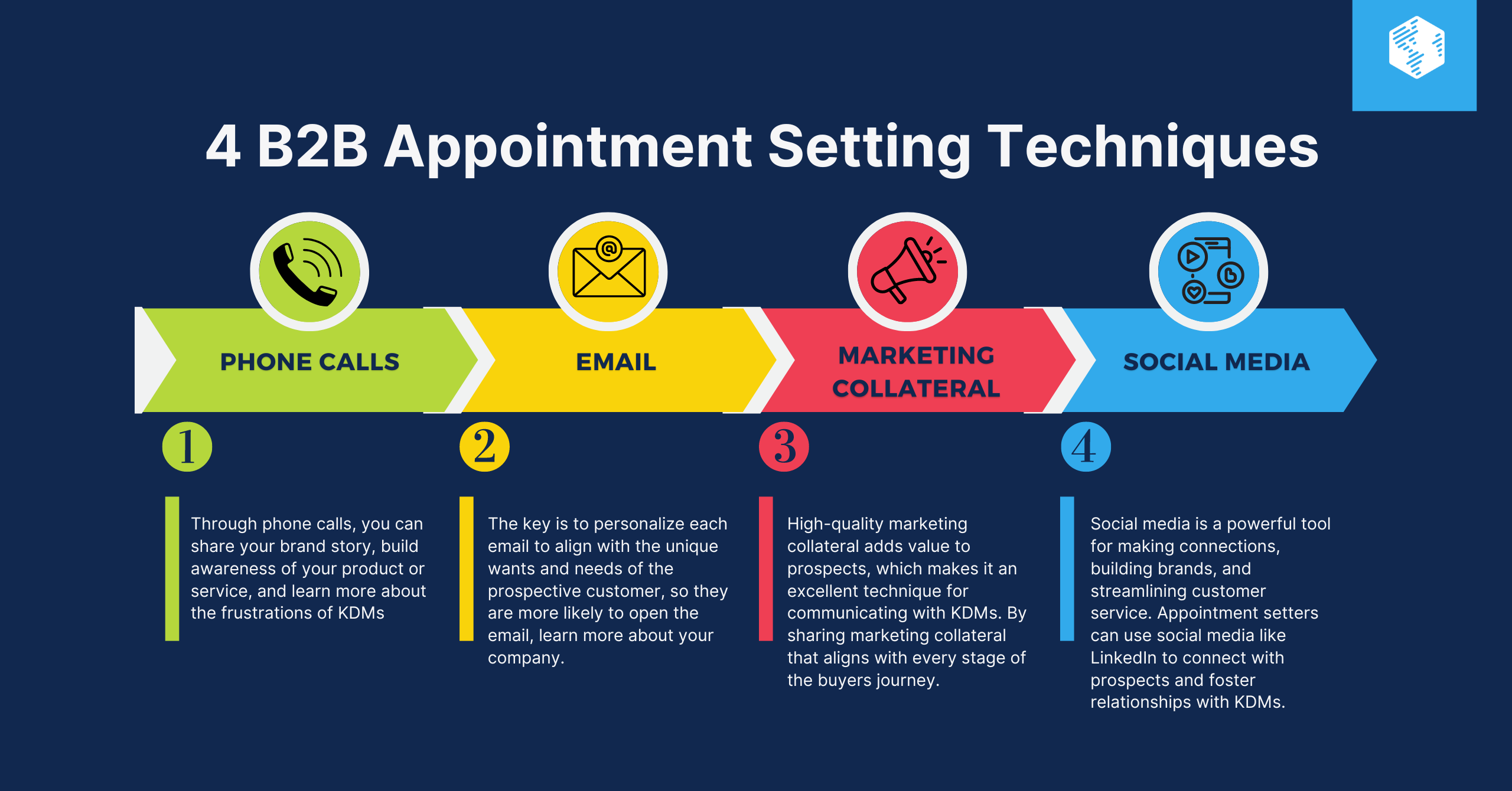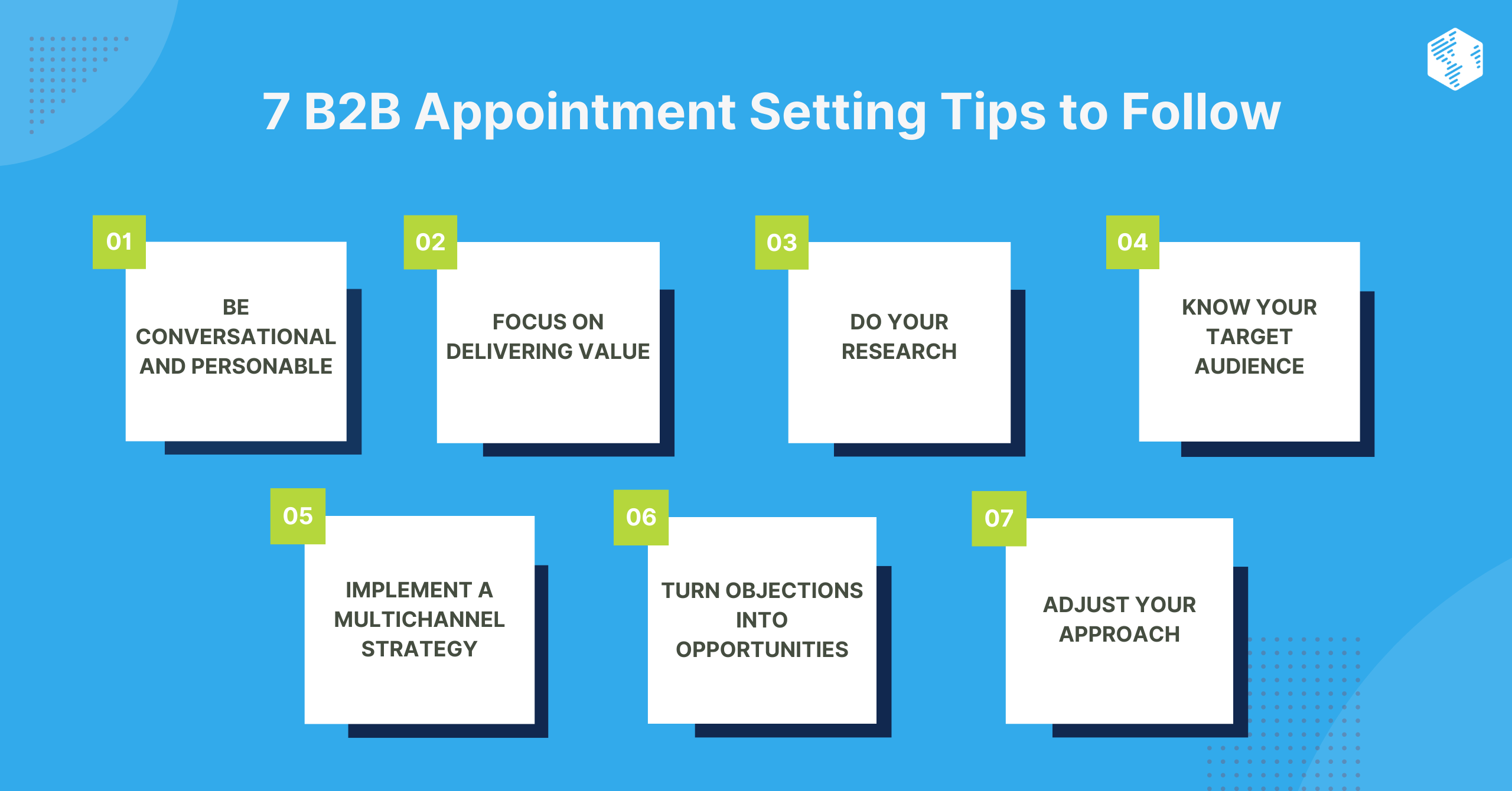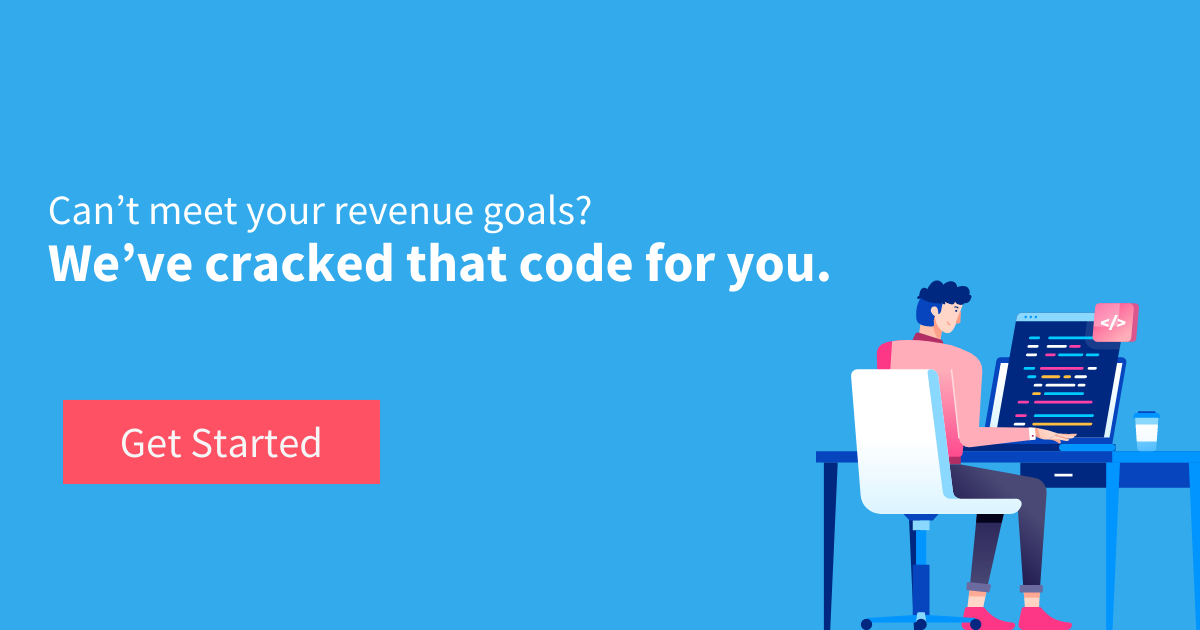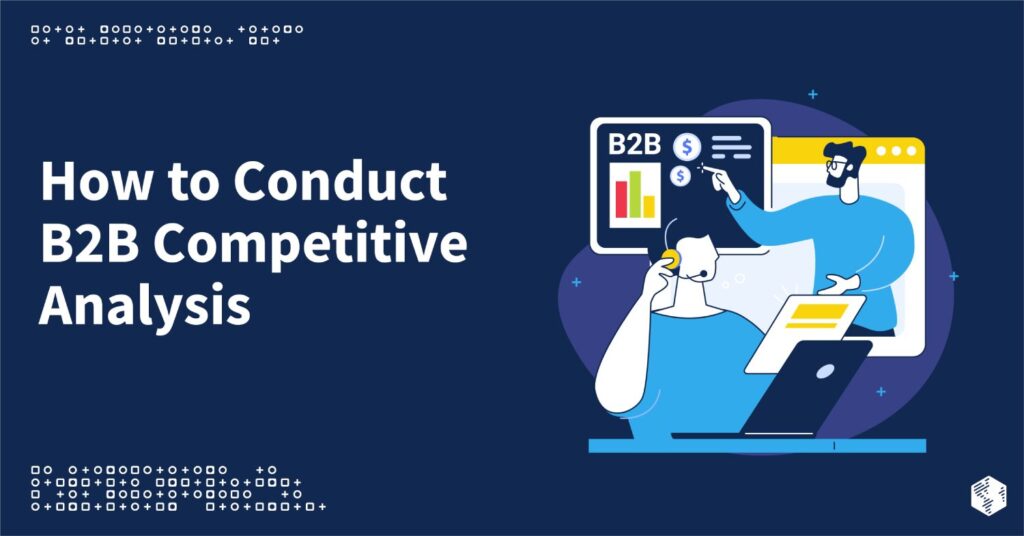Your perfect customer is out there—and it’s your goal to find them.
An important part of the business-to-business (B2B) sales process is to identify and build relationships with ideal clients, hopefully leading to a purchase. In the past, B2B sales representatives did it all: researched ideal customers, pre-qualified leads, started the conversation, fostered a relationship, met with a variety of stakeholders, and finally—maybe—closed the deal. However, while each sales representative may be able to handle every aspect of the sales process on their own, they don’t have to.
There’s a better way.
With an appointment setting strategy in place, your sales team can divide and conquer responsibilities to work more efficiently and streamline the entire B2B sales process.
What Is B2B Appointment Setting?
B2B appointment setting is a sales and business growth strategy focused on identifying and pre-qualifying prospects, building relationships with leads, and scheduling sales appointments between the qualified lead and your B2B company.
During the appointment setting process, appointment setters talk one-on-one with key decision makers (KDMs), stakeholders, and business owners to learn their pain points and share how your B2B organization can meet their needs.
The Sales Development Representative (SDR) Role
Appointment setters usually hold a sales development representative (SDR) role in your B2B organization’s sales department. These specialized reps reach out to cold leads, contact prospects, follow up with qualified leads, and schedule sales meetings.
An important part of the SDR role is to qualify leads by confirming prospects are a good fit for your B2B company’s products or services.
Overall, appointment setters or SDRs have the goal of building relationships with potential buyers.
Stages of the B2B Appointment Setting Process
There are several stages in the B2B appointment setting process:
- Defining ideal customers through buyer personas
- Identifying prospects at target companies
- Researching KDMs and gathering information for personalized outreach
- Contacting prospects through various channels
- Setting appointments with internal sales staff
Then, an executive sales representative can take over the relationship, guiding the prospect through the final steps of the sales funnel.
B2B Lead Generation and Appointment Setting
B2B appointment setting is an excellent lead generation strategy.
When researching and contacting prospects, SDRs communicate with KDMs that you may not have been able to meet through other, organic inbound marketing approaches. They find prospects through a variety of channels and encourage them to enter the sales pipeline.
Appointment setters then qualify leads to ensure they’re only pursuing KDMs who meet the criteria of your B2B organization’s ideal customer. Additionally, they ensure prospects are the right people to contact—in other words, that the stakeholder is able to make a purchasing decision on behalf of the company.
Lead nurturing is another component of appointment setting. Through the appointment setting process, SDRs communicate with prospects, building top-of-mind awareness and reminding them about your B2B products or services.
Finally, whenever the prospect is ready to purchase, the appointment setter connects them to an executive sales representative, who will present a customized pitch and convert the KDM from a lead to a customer.
Lead generation and B2B appointment setting go hand in hand.
The Importance of Appointment Setting for B2B Companies
Appointment setting has a variety of benefits for B2B companies:
- Reduces the length of your average sales cycle
- Makes prospects are more likely to convert
- Gives sales reps more accurate information on potential customers
- Ensures leads receive proper attention and follow-up
- Allows executive sales reps to focus solely on the most qualified prospects
- Provides an organized, up-to-date database of prospect information
By delegating the task of identifying and pre-qualifying leads to appointment setters, you can allow your executive sales representatives to dedicate their time to qualified leads. Your sales reps can focus on the prospects who are the best fit for your products or services, and your overall sales pipeline can accelerate and grow.
4 B2B Appointment Setting Techniques
SDRs or sales staff in appointment setting roles connect with prospects through various methods. Each technique has its own strengths and benefits. A multichannel approach—combining these four appointment setting techniques—is the most effective at reaching the right KDMs at the right time.
1. Phone Calls
Cold calling is still an effective way to build relationships with prospects. Through phone calls, you can share your brand story, build awareness of your product or service, and learn more about the frustrations of KDMs—and, of course, share how your B2B company can alleviate their concerns.
2. Email
Emails are another important communication technique. Some KDMs are easier to reach by email than via a phone call, so take advantage of this channel through a robust email marketing strategy.
The key is to personalize each email to align with the unique wants and needs of the prospective customer, so they are more likely to open the email, learn more about your company, agree to meet with an SDR, and close a deal with an executive sales representative.
3. Marketing Collateral
High-quality marketing collateral adds value to prospects, which makes it an excellent technique for communicating with KDMs. By sharing marketing collateral that aligns with every stage of the buyer’s journey, appointment setters can guide prospects through the sales funnel.
4. Social Media
Social media is a powerful tool for making connections, building brands, and streamlining customer service. Appointment setters can use social media like LinkedIn to connect with prospects and foster relationships with KDMs.
READ: Top 10 Challenges in B2B Sales And How to Overcome Them
How to Tell When Your Company Needs to Implement a B2B Appointment Setting Strategy
Some B2B companies can benefit significantly from an appointment setting strategy, but others may not need to fully invest in appointment setting (yet).
Is your organization ready to implement a B2B appointment setting strategy? Keep an eye out for these signs.
Sign #1: Your Sell High-Ticket Products or Services
If your B2B company specializes in large deals, high-ticket services, or expensive products, then closing a sale likely requires input from many different KDMs before a purchasing decision can be made. Appointment setters find and follow up with these various stakeholders, which means your sales representatives can focus their efforts on closing deals instead of nurturing leads.
Sign #2: You Have Lengthy Sales Cycles
Does your B2B organization tend to experience long sales cycles? If so, you likely sell a high involvement product or service.
An appointment setting strategy helps reduce the length of your overall sales cycle—SDRs take on the role of identifying and scheduling appointments with qualified leads, so your executive sales staff can spend their time closing deals with qualified prospects who are ready to make a purchasing decision.
With such a strategy in place, the sales cycle is divided and conquered, shortening the sales process.
Sign #3: Your Sales Reps Are Overburdened
Without dedicated SDR staff taking on lead qualification and appointment setting, those responsibilities are shared throughout the sales staff. You risk overburdening your sales representatives, which can lead to a burnout.
Appointment setters find and pre-qualify leads as well as schedule appointments with interested buyers so your executive sales staff can focus on selling to KDMs.
7 B2B Appointment Setting Tips to Follow
Your B2B company may decide to hire additional sales staff to fill an appointment setting role or ask current employees to cover appointment setting responsibilities. Either way, your SDRs can follow these tips to improve their appointment setting skills.
1. Be Conversational and Personable
The relationship between SDR and KDM requires trust and connection.
Knowing how to carry a conversation is a key skill for any salesperson, including appointment setters. The goal should be to get to know what prospects need and to determine if your B2B company meets those needs, so take a conversational approach, be personable, and ask open-ended questions when communicating with KDMs.
2. Focus on Delivering Value
With every phone call, email, social media message, or other communication, prioritize delivering value to KDMs. The focus of all conversations should be how your B2B organization brings value, solves problems, addresses concerns, and is essential for the prospect’s everyday business operations.
The value your company can bring to the table is an appointment setter’s best weapon.
READ: B2B Sales: Best Strategies To Grow Your Sales Pipeline With Examples
3. Do Your Research
The last thing you want to do is waste time communicating with someone at the target company who doesn’t have any decision-making power. That’s why it’s important for SDRs to research the company, find the best prospects, and figure out who the KDMs are before moving forward—all before reaching out to specific contacts or setting up appointments with closing sales representatives.
4. Know Your Target Audience
Buyer personas are a powerful tool for any marketing or sales professional when it comes to learning about the behaviors of a target audience. Study the buyer personas to become familiar with your target audience—especially the issues they face on a daily basis.
5. Implement a Multichannel Strategy
Don’t just stick to cold calls. Instead, take a multichannel approach to prospect outreach.
For example, you could start by connecting with a KDM on LinkedIn and then sending an email, during which you ask to set up a phone call. With every touchpoint, you increase your chances of the prospect recognizing your brand and agreeing to meet with you.
6. Turn Objections into Opportunities
What should you do when you hear an objection? Appointment setters should turn objections into opportunities. Instead of giving up and moving on to the next prospect at the first sign of reluctance, experienced SDRs use objections as opportunities to learn more about what KDMs need and what problems they are trying to solve.
Why waste these opportunities to improve your B2B appointment setting strategy?
7. Adjust Your Approach
The best appointment setters actively adjust their sales approach when the situation calls for it. If prospects aren’t resonating with your outreach attempts or moving through the sales pipeline, make changes to your pitch to ensure it aligns with what KDMs in your target market are looking for.
What Every B2B Appointment Setting Script Needs to Include
You can’t predict what will happen during conversations with prospects. Their tone, the questions they ask, their attitude, how they speak to you—any deviation from the norm may disorient a SDR during the appointment setting conversation. That’s why all SDRs need a script.
An appointment setting script is an essential tool for any B2B appointment setter. These scripts are helpful for SDRs to have on their desk or pulled up on their computer screens while making calls to prospects. With a strong script to support their work, appointment setters are better prepared to control the conversation, deal with reluctance from prospects, and confidently deliver value to KDMs.
To ensure they are effective, make sure every appointment setting script you create includes these sections.
Ideas for Conversation Starters
The conversation starts with an introduction. Include several options for greetings and conversation starters in your appointment setting script so SDRs get off on the right foot.
Answers to Frequently Asked Questions (FAQs)
What are the questions prospects frequently ask? Keep a list of FAQs and their answers in the script as a resource that SDRs can reference throughout the appointment setting conversation.
A List of Pre-Qualifying Conditions
One of the most important responsibilities of appointment setters is to determine whether a KDM is a qualified lead. Will they move further down the sales funnel and make a purchase? How can you tell if a lead is qualified or not?
Create a checklist of pre-qualifying conditions to make it easy for SDRs to tell if a prospect is a qualified lead.
A Detailed Value Proposition
The key component of any sales pitch is the value proposition—how your product or service solves the prospect’s pain points and why your company is the best choice for the KDM. Write out a detailed value proposition to direct the conversation and ensure the SDR’s message is centered around bringing value to the table.
An Outline of Next Steps
When it’s time to end the conversation, give SDRs a guide to negotiate the next steps. Clarify how they should follow up, either by getting more information from a prospect or scheduling an appointment between the KDM and a closing sales representative.
B2B Appointment Setting Tools and Software
B2B appointment setters and SDRs may handle 100+ prospects a day—that’s a lot of conversations to keep in mind and details to remember. Even the most enthusiastic SDR would find the task impossible.
Fortunately, there are many different tools and software on the market to help with appointment setting. The most important types to have on hand are some kind of customer relationship management (CRM) platform and a scheduling tool.
Customer Relationship Management (CRM) Platforms
CRMs manage customer relationships and interactions across the sales cycle—and the best SDRs see the value in using these tools to their advantage.
Appointment setters can use CRM platforms like HubSpot or Salesforce to keep track of prospects, leave notes to help remember conversations, track KDM data, and easily pass along relevant info to the appropriate closing sales representative.
Scheduling Tools
How can SDRs organize appointments with prospects? Instead of going back-and-forth with KDMs and closing sales reps to figure out the best time to schedule a meeting, appointment setters can use a scheduling tool like Calendly or HubSpot’s Meeting Scheduler to consolidate various calendars and streamline appointment setting.
Conclusion
Are you ready to streamline your B2B sales process? We can help.
At OneIMS, we pride ourselves on helping B2B companies adopt sales strategies to become better aligned and integrated. Our HubSpot experts can manage your marketing and sales teams throughout the buyer’s journey and from beginning to end of the sales funnel. We have the strategies, solutions, and tools you need to transform your sales team into a revenue-generating machine.
But you don’t have to take our word for it. View testimonials from our clients and read our blog to get an idea of our training, experience, and track record of success.
If you want to see what OneIMS and HubSpot can do for you, schedule a consultation with us today.


